The GeForce GTX 1060 Founders Edition & ASUS Strix GTX 1060 Review
by Ryan Smith on August 5, 2016 2:00 PM ESTOverclocking
For our final evaluation of our GTX 1060 cards, let’s take a look at overclocking.
We’ll start things off with NVIDIA’s GeForce GTX 1060 Founders Edition. This card has a 3+1 power delivery system and a 116% TDP limit. Like the earlier GTX 1080 and 1070 cards, the GTX 1060FE can be “overvolted” to 1.093v to unlock an additional boost bin.
| GeForce GTX 1060FE Overclocking | ||||
| Stock | Overclocked | |||
| Core Clock | 1506MHz | 1706MHz | ||
| Boost Clock | 1709MHz | 1909MHz | ||
| Max Boost Clock | 1911MHz | 2100MHz | ||
| Memory Clock | 8Gbps | 9Gbps | ||
| Max Voltage | 1.062v | 1.093v | ||
We were able to overclock the GTX 1060FE’s GPU an additional 200MHz (12%), bringing the boost clock to 1909MHz. Unsurprisingly, this is very similar to the GTX 1080 and 1070, both of which overclocked by around 200MHz as well. Consequently it looks like both GP104 and GP106 seem to have similar voltage/frequency curves. Meanwhile we were able to push the memory another 1Gbps (13%) to 9Gbps.
Our other GTX 1060 is ASUS’s ROG Strix GTX 1060 OC. This card features a more advanced cooler and 6+1 power delivery system, but it also ships with a factory overclock. So all things held equal it’s likely that there’s not as much headroom for additional end-user overclocking. Meanwhile the card also ships with a built-in OC setting via ASUS’s GPU Tweak II software, which offers a small, virtually guaranteed overclock.
| ASUS Strix GTX 1060 OC Overclocking | |||||
| Stock | OC Mode | Overclocked | |||
| Core Clock | 1620MHz | 1646MHz | 1720MHz | ||
| Boost Clock | 1848MHz | 1874MHz | 1948MHz | ||
| Max Boost Clock | 2025MHz | 2050MHz | 2113MHz | ||
| Memory Clock | 8.2Gbps | 8.2Gbps | 9.2Gbps | ||
| Max Voltage | 1.062v | 1.062v | 1.093v | ||
As expected, due to its factory overclock the ASUS GTX 1060 doesn’t offer quite as much end-user overclocking. We were able to add another 100MHz (5%) to the GPU, half that of the stock clocked GTX 1060FE. Though it should be noted that in absolute terms the ASUS card has overclocked a bit farther than NVIDIA’s card, with a base clock 14MHz higher and a boost clock 39MHz higher. Meanwhile we got a slightly higher memory overclock out of the card as well, with the card topping out at 9.2Gbps, 1Gbps (12%) over the card’s shipping memory frequency.

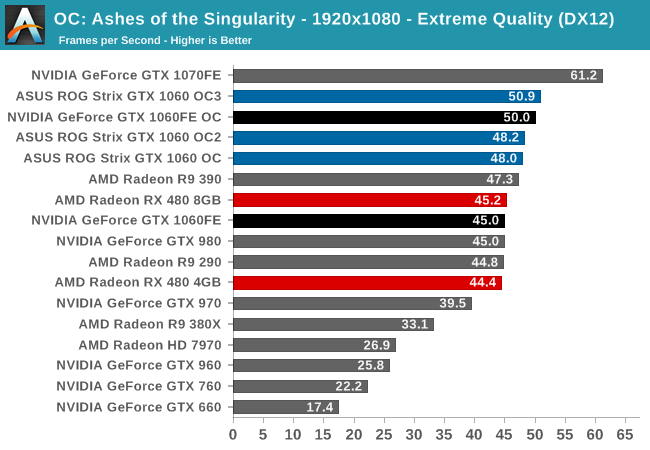
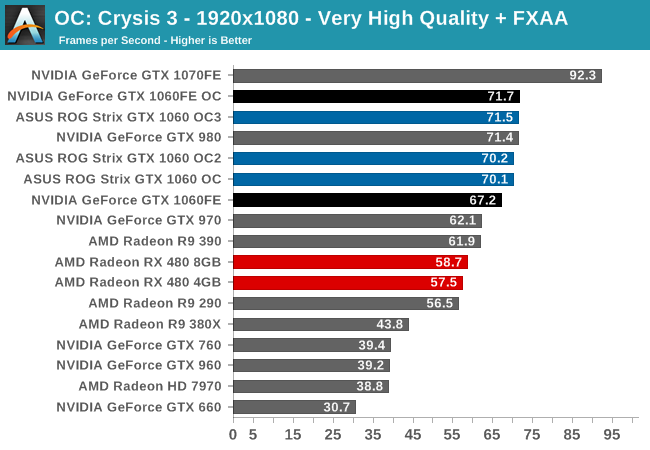

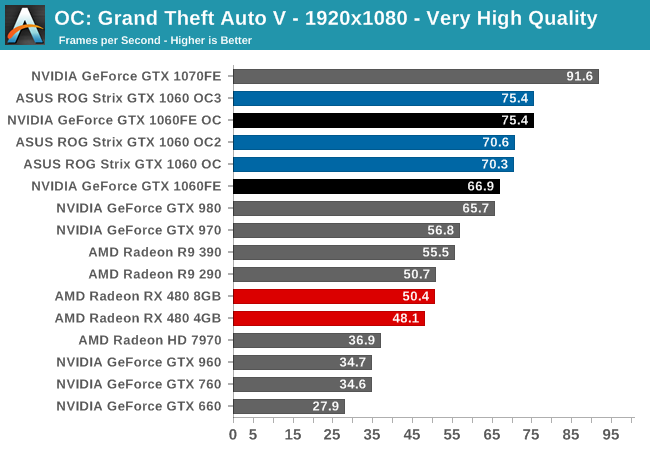
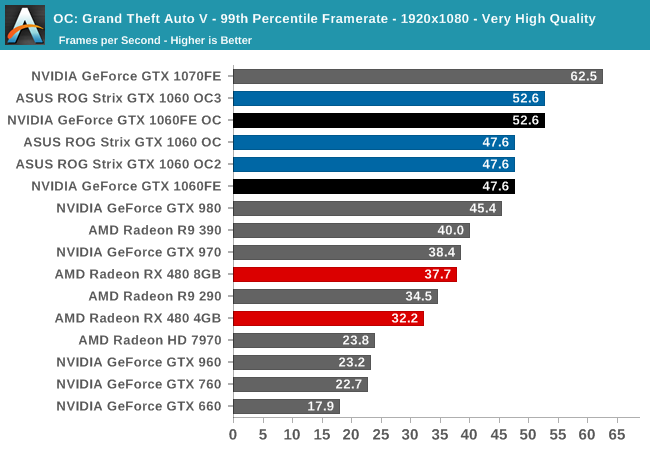
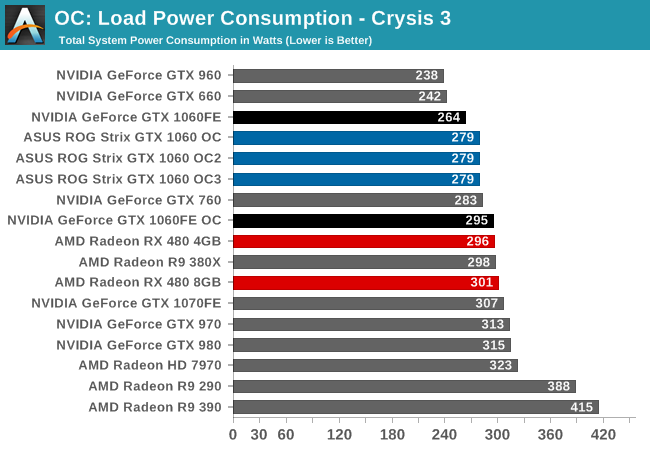
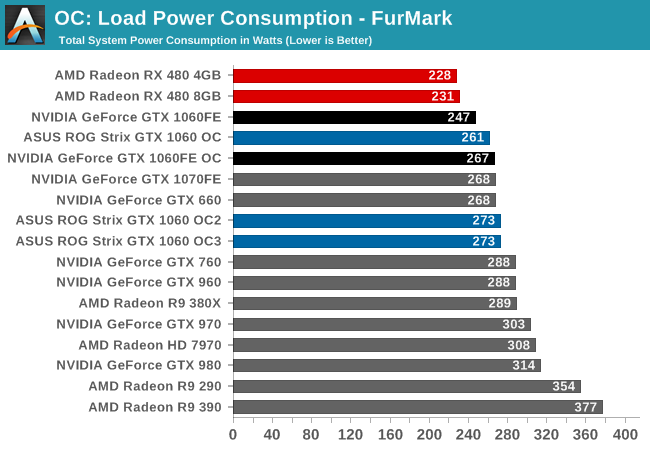
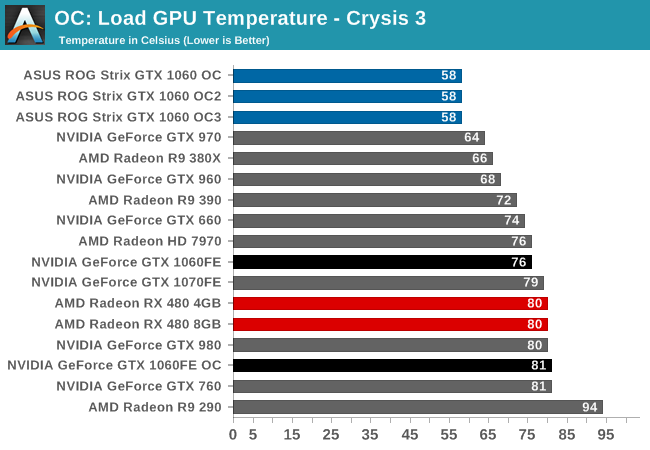
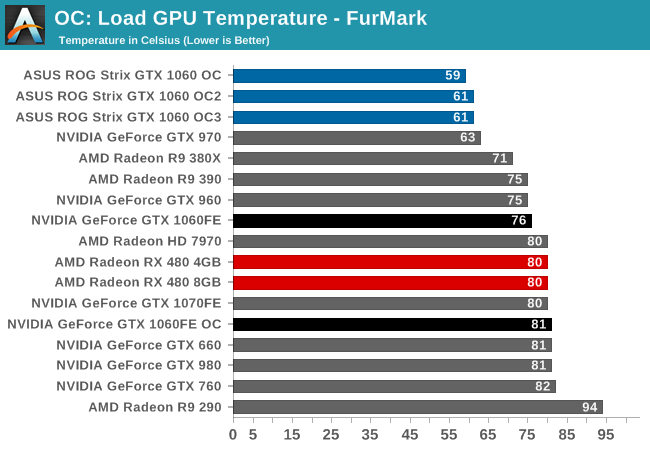
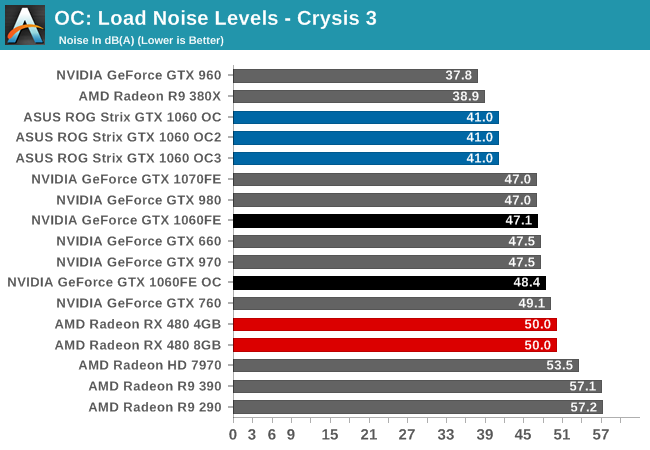
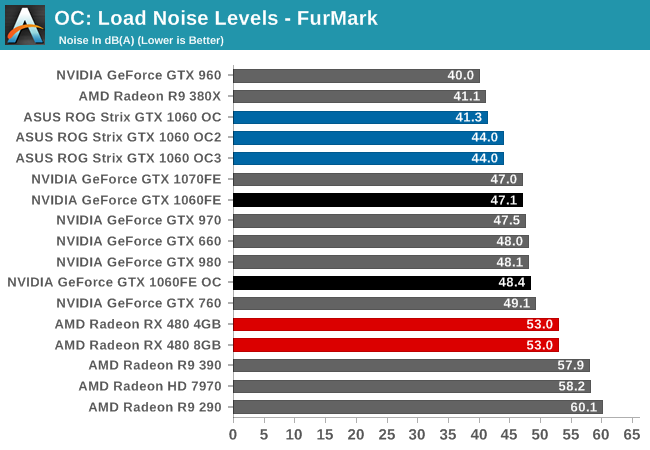
The overall performance gains and resulting power/temperate/noise costs are about as expected. The additional overclock helps the performance of the GTX 1060, but it’s nowhere near enough to close the gap with the GTX 1070. Meanwhile the final overclocks of the NVIDIA and ASUS cards are close enough that their peak performance is neck-and-neck.










189 Comments
View All Comments
Mikuni - Saturday, August 6, 2016 - link
Avidemux works pretty well.onemoar@gmail.com - Saturday, August 6, 2016 - link
here is my luxmark scoreoverclocked EVGA GTX 1060SC
http://www.luxmark.info/node/2919
Mustalainen - Saturday, August 6, 2016 - link
I think i have commented once or twice on any article here but just had to do it again. The people in the comment section are just out right arrogant. You expect the reviewer to provide the detailed reviews on the same day a product is released? Can you guys cut the guys at Anandtech some slack? I bet they do their best in order to provide us with these reviews (which by the way are free). If you are not happy with the quality of the article, go somewhere else (but i bet you always come back here just because these guys do a great job). So what if the review is lagging with a month or two, if you are such an enthusiast go and buy the card/device yourself.fanofanand - Saturday, August 6, 2016 - link
They would receive their samples weeks ahead of time. How do you think so many day 1 reviews get posted?Sushisamurai - Saturday, August 6, 2016 - link
there is some truth to @fanofanand, but that's assuming anandtech also gets their review samples ahead of time as well - which you really can't prove. Those assumptions can be toxic.Mustalainen - Sunday, August 7, 2016 - link
So assuming this is not the authors full time job they should try to rush the review for the release date? And as stated in the other comment, you can only assume they get review samples ahead of time? There are so many day 1 reviews from other sources because when they have receive the review sample the review is about reading the technical details on the box (and test 5-10 different games and report the fps if its a gpu). Do you want Anandtech to become such an site?yannigr2 - Saturday, August 6, 2016 - link
This review makes GTX 1060 look much better than RX 480, compared to other reviews. Just an observation.MarkieGcolor - Saturday, August 6, 2016 - link
Agreed. AMD really needs to release their high end. I wonder if they are in cahoots with Nvidia. Why wouldn't they release a card that can beat titan x when they totally could? With this new process both companies are holding backsilverblue - Sunday, August 7, 2016 - link
Vega isn't ready yet, that's why they've not done it.Jman13 - Tuesday, August 9, 2016 - link
That's because they ignored a lot of things where the 480 is better: such as DX12 on RotTR, where the 480 pulls essentially even with the 1060. The games list also ignores Doom, which is a HUGE win for the 480, and is included in most other review sites games suites. I understand the difficulty in altering and adding games to the suite, but I do think the discussion could have focused on the fact that there is a split between these two cards depending on which APIs are used. The 1060 is clearly the better card in DX 11 games. The 480 has generally performed very well in DX 12 games, being even in some and notably better in others. The only Vulkan game, Doom, shows a HUGE lead for the RX 480, but who knows how representative that is at this point.Long term, the 480 will probably be the faster card for newer games that use DX12, while the 1060 will be faster for most current and older games, as well as several newer games for the next year.